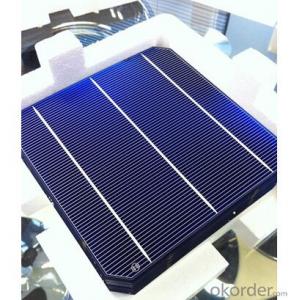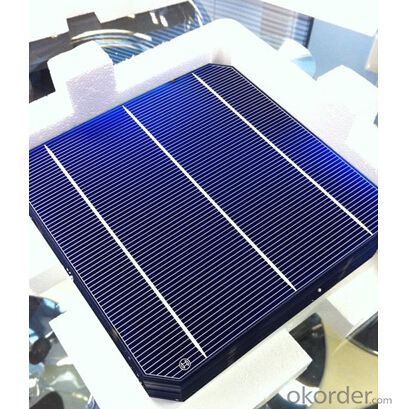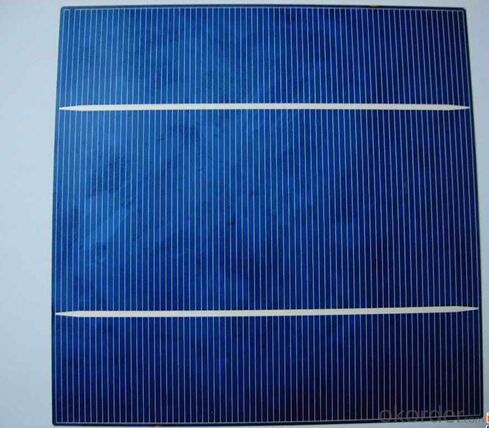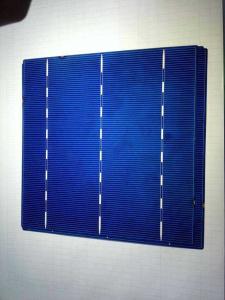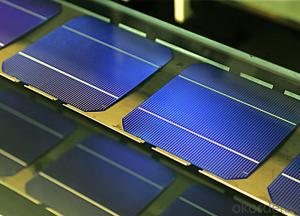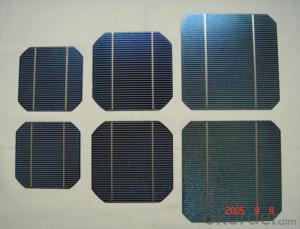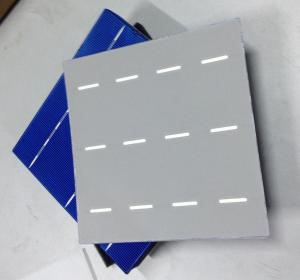C Si Solar Cells - 25 Years Life Time - 17.8% Efficiency - World-Beating Performance
- Loading Port:
- Shanghai
- Payment Terms:
- TT OR LC
- Min Order Qty:
- 1000 pc
- Supply Capability:
- 5000000 pc/month
OKorder Service Pledge
OKorder Financial Service
You Might Also Like
Brief Introduction of Solar Cells
A solar cell, is an electrical device that converts the energy of light directly into electricity by the photovoltaic effect, which is a physical and chemical phenomenon. It is a form of photoelectric cell, defined as a device whose electrical characteristics, such as current, voltage, or resistance, vary when exposed to light. Solar cells are the building blocks of photovoltaic modules, otherwise known as solar panels.
Introduction of our Company
We are a producer of bifacial photovoltaic (PV) crystalline silicon solar cells that provide 25% and beyond more electricity per cell at a standard cell production cost, lowering the LCOE, doubling the PV project IRR and cutting its payback time.
Our bifacial cell delivers industry leading equivalent cell efficiency with over 21% today and a target of over 24% in the near future. Our cell is the best solution for flat rooftop and ground installations, as well as for PV trackers, sound barriers, car ports, facades and some forms of BIPV.
Our manufactures its bifacial high-performance, high-quality, mono c-si cells in its 30 MWp/year plant in Heilbronn, Germany and is on track with a four-year target of reaching a bifacial cell production capacity of 500 MW/year worldwide.
The PV market has turned into a commodity market where most vendors offer similar products without differentiation. Cell efficiencies are reaching a ceiling and current players are only able to offer marginal improvements through higher production costs. Our bifacial cell offers a disruptive solution targeted at the mainstream of the PV value chain; p-type, 6’’ silicon cells, with an unprecedented combination of high efficiency and low production cost.
Specifications of Polycrystalline Solar Cells
Format: 156 mm × 156 mm ± 0.5 mm
Thickness: 210 μm ±40 μm
Front (-) : 1.5mm bus bars (silver),blue anti-reflection coating (silicon nitride)
Back (+) : 2.5mm wide soldering pads (silver) back surface field (aluminium)
Efficiency (%) | Pmpp (W) | Umpp (V) | Impp (A) | Voc (V) | Isc (A) |
18.00% | 4.38 | 0.528 | 8.291 | 0.631 | 8.869 |
17.80% | 4.33 | 0.525 | 8.252 | 0.629 | 8.821 |
17.60% | 4.29 | 0.532 | 8.053 | 0.633 | 8.541 |
17.40% | 4.23 | 0.528 | 8.092 | 0.624 | 8.632 |
17.20% | 4.19 | 0.524 | 7.992 | 0.62 | 8.458 |
17.00% | 4.14 | 0.52 | 7.972 | 0.623 | 8.5 |
Advantage of Polycrystalline Solar Cells
1. Tire-1 Solar Cells’ Manufacturer Quality Guarantee. With a complete and sophisticated quality government system, our Quality Management have arrived world’s leading place. Customer can receive Tire-1 Cells Maker’s Quality Standard Products.
2. Trusted Warranty. We can supply trusted after-sales service to our customer. If our cells are found not in conformity to the specification of manufacturer, or should the inspected quantity found in shortage, or should the packing found damaged, the buyer has the right to claim to the seller. The claim, if any, should be presented to seller within 30 days after cargo's arrival date to the port, together with related inspection report and photos issued and provided by a reputable independent surveyor such as SGS.
3. World’s Leading Manufacturer Equipment. We imported the newest and leading production equipment from abroad. Advanced equipment can guarantee the stable quality of cells. Auto production line can also save labor cost which will further cut our production cost.
4. Bulk supply: With the production capacity of 500MW, we can produce large quantity every month. This can satisfy most customer requirement.
Usage of Polycrystalline Solar Cells
Solar cells are often electrically connected and encapsulated as a module. Photovoltaic modules often have a sheet of glass on the front (sun up) side, allowing light to pass while protecting the semiconductor wafers from abrasion and impact due to wind-driven debris, rain, hail, etc. Solar cells are also usually connected in series in modules, creating an additive voltage. Connecting cells in parallel will yield a higher current; our solar cells have passed IEC Certification. With high and stable quality, our cells can greatly improve the performance of Solar Modules.
Applications of Polycrystalline Solar Cells
Assemblies of photovoltaic cells are used to make solar modules which generate electrical power from sunlight, as distinguished from a "solar module" or "solar panel". A solar array generates solar power using solar energy.
Packaging & Delivery of Polycrystalline Solar Cells
Carton Box Package and Deliver by air. It should be noticed that it should be avoid of water, sunshine and moist.
Factory Picture of Solar Cells
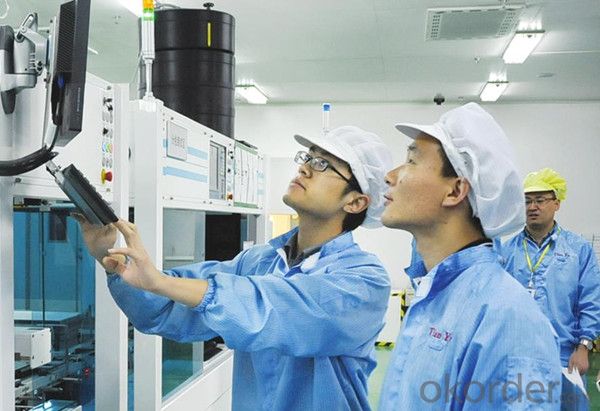

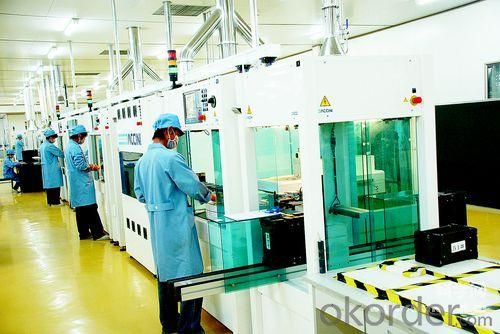
FAQ
We have organized several common questions for our clients,may help you sincerely:
1. What’s price per watt?
A: It’s depends on the quantity, delivery date and payment terms of the order. We can talk further about the detail price issue. Our products is high quality with lower price level.
2. Can you tell me the parameter of your solar cells?
We have different series of cells with different power output, both from c-si to a-si. Please take our specification sheet for your reference.
3. How do you pack your products?
We have rich experience on how to pack the panels to make sure the safety on shipment when it arrives at the destination.
4. Can you do OEM for us?
Yes, we can.
5. How long can we receive the product after purchase?
In the purchase of product within three working days, We will arrange the factory delivery as soon as possible. The perfect time of receiving is related to the state and position of customers. Commonly 7 to 10 working days can be served.
- Q: Can solar cells be used in recreational vehicles?
- Yes, solar cells can be used in recreational vehicles (RVs). Solar panels can be installed on the roof of an RV to harness sunlight and convert it into electricity, which can then be used to power various appliances and systems within the vehicle. This allows RV owners to enjoy the benefits of renewable energy while traveling and reduces the need for traditional power sources.
- Q: How do solar cells handle hail or other severe weather conditions?
- Solar cells are designed to be durable and withstand various weather conditions, including hail and severe weather. They are made with sturdy materials like tempered glass or polycrystalline silicon, which can endure hailstorms without significant damage. Additionally, solar panels undergo rigorous testing to ensure their ability to withstand impact and extreme weather events.
- Q: Can solar cells be used for space applications?
- Yes, solar cells can be used for space applications. Solar cells are commonly used in space missions to convert sunlight into electricity, providing power to satellites, space probes, and even manned spacecraft. The abundance of sunlight in space makes solar cells an ideal and reliable source of energy for various space applications.
- Q: The history of solar cells
- lithium sulfur dioxide battery and lithium thionyl chloride battery is very characteristic. Their positive electrode active material is also the solvent of the electrolyte. This structure only occurs in the electrochemical system of non-aqueous solution. Therefore, the research of lithium batteries has also promoted the development of nonaqueous system electrochemical theory. In addition to the use of various non-aqueous solvents, people also carried out the polymer thin film battery research.
- Q: Anybody ever heard of solar roll flexible solar panel?
- It could be a portable solar panel charges your digital camera, camcorder, GPS, and satellite phone. Expedition members no longer need to pack heavy batteries for their worldwide journeys.
- Q: How do solar cells affect the value of a property?
- Solar cells can significantly increase the value of a property due to their ability to generate clean and renewable energy. The presence of solar panels can enhance the property's appeal, lower energy costs, and potentially provide a source of income through net metering or selling excess energy back to the grid.
- Q: Can solar cells be used in educational institutions?
- Yes, solar cells can definitely be used in educational institutions. In fact, they can serve as valuable teaching tools for students to learn about renewable energy, sustainability, and the importance of reducing carbon footprint. By installing solar cells on the premises, educational institutions can also save on electricity costs and set an example for the community by embracing clean energy solutions.
- Q: How can I calculate the cost of using solar cells if I put a fully-functional solar system in my house?
- The installation is more expensive than using it.
- Q: What materials are used in solar cells?
- The materials used in solar cells primarily include silicon, which is the most commonly used semiconductor material, along with other elements such as gallium, indium, and selenium. These materials help convert sunlight into electricity through the photovoltaic effect.
- Q: What is the role of charge controllers in solar cell systems?
- The role of charge controllers in solar cell systems is to regulate and optimize the charging process of the batteries connected to the solar panels. They monitor the voltage and current levels from the panels and ensure that the batteries are charged efficiently and safely. Charge controllers also protect the batteries from overcharging, over-discharging, and other potential damage, ultimately extending their lifespan.
Send your message to us
C Si Solar Cells - 25 Years Life Time - 17.8% Efficiency - World-Beating Performance
- Loading Port:
- Shanghai
- Payment Terms:
- TT OR LC
- Min Order Qty:
- 1000 pc
- Supply Capability:
- 5000000 pc/month
OKorder Service Pledge
OKorder Financial Service
Similar products
Hot products
Hot Searches
Related keywords
